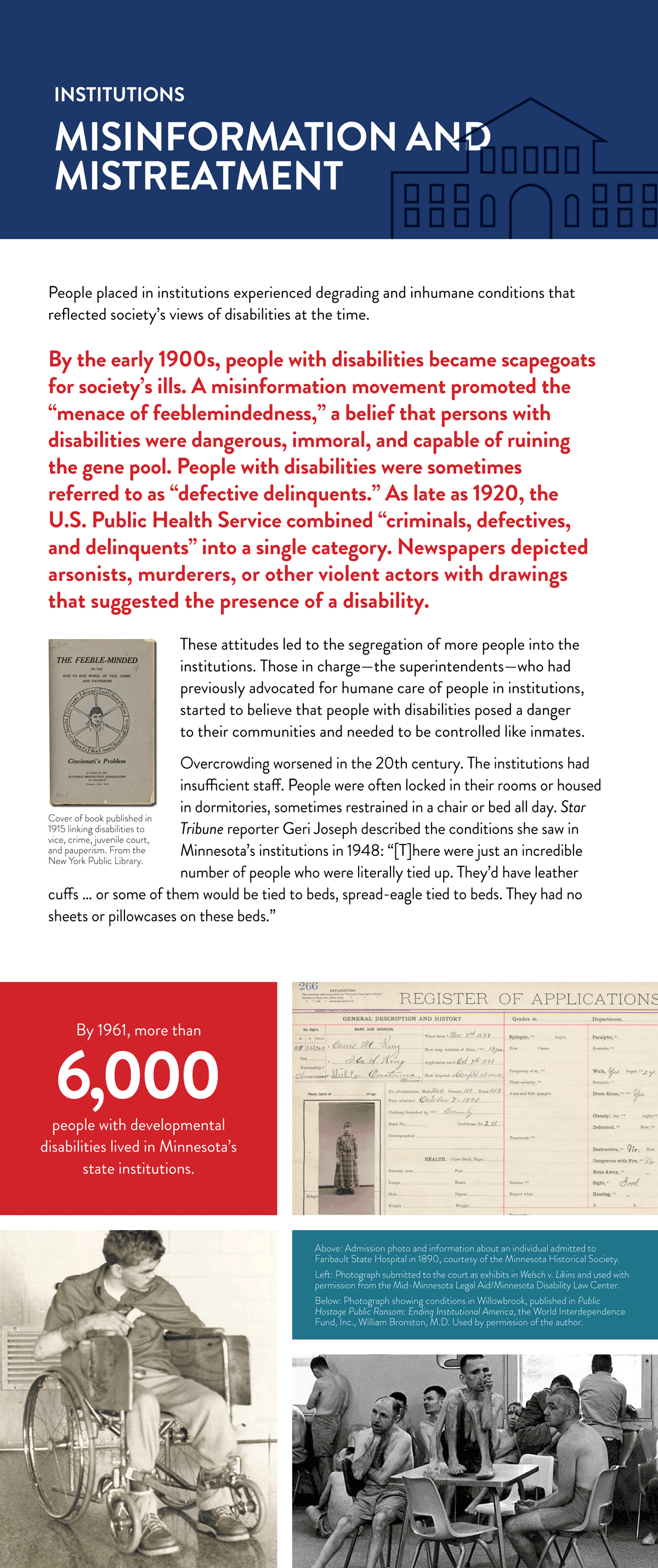An Unfinished Journey:
Civil Rights for People with Developmental Disabilities and the Role of the Federal Courts
Banner 5: Misinformation and Mistreatment
View the PDF of all banners »
Return to Banner Index »
Institutions: Misinformation and Mistreatment
People placed in institutions experienced degrading and inhumane conditions that reflected society's views of disabilities at the time.
By the early 1900s, people with disabilities became scapegoats for society's ills. A misinformation movement promoted the "menace of feeblemindedness," a belief that persons with disabilities were dangerous, immoral, and capable of ruining the gene pool. People with disabilities were sometimes referred to as "defective delinquents." As late as 1920, the Public Health Service combined "criminals, defectives, and delinquents" into a single category. Newspapers depicted arsonists, murderers, or other violent actors with drawings that suggested the presence of a disability.
These attitudes led to the segregation of more people into the institutions. Those in charge—the superintendents—who had previously advocated for humane care of people in institutions, started to believe that people with disabilities posed a danger to their communities and needed to be controlled like inmates.
Overcrowding worsened in the 20th century. The institutions had insufficient staff. People were often locked in their rooms or housed in dormitories, sometimes restrained in a chair or bed all day. Star Tribune reporter, Geri Joseph, described the conditions she saw in Minnesota's institutions in 1948: "[T]here were just an incredible number of people who were literally tied up. They'd have leather cuffs … or some of them would be tied to beds, spread-eagle tied to beds. They had no sheets or pillowcases on these beds."
By 1961, more than 6,000 people with developmental disabilities lived in Minnesota's state institutions.
Photo: Black and white book cover published in 1915 and is a drawing of a man encircled by a wheel with words, vice, crime, juvenile court, and pauperism, courtesy of New York Public Library.
Photo: This photo is taken of a register of applications to Faribault State Hospital and shows page 266, an admission from 1890. Details about her date of birth, her nationality, her disability, and the cause of death are handwritten. The photo shows a young female, and she is standing facing the camera wearing a very long dress to her ankles, courtesy of Minnesota Historical Society.
Photo: Sepia tone photo of a young white man with a mustache sitting in a metal wheelchair with wooden sides wearing a shirt, trousers, and shoes. He is strapped to the wheelchair at his wrists and at his ankles. Photo courtesy of Mid-Minnesota Legal Aid/Minnesota Disability Law Center.
Photo: Black and white photo of ten men in a room at Willowbrook. All the men have buzz cut hair. Most are wearing only underpants and two are also wearing shirts. Some are standing and some are sitting. In the foreground, two men are sitting across from each other at a square table and a third man is sitting on top of the table with his knees to his chest. Photo courtesy of William Bronston.

